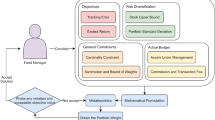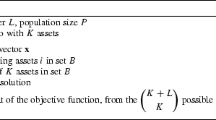Abstract
Investing vast amounts of money with the goal of fostering medium to long-term growth in returns is a challenging task in financial optimization. A method might be mirroring the market index as closely as possible by choosing from the stocks that make up the index. This approach is known as index tracking and the objective of this paper is to address this problem in order to solve it by means of mathematical programming techniques. In particular, we are interested in investigating the index tracking problem (ITP) as a mixed integer linear program in presence of some real-world constraints known as cardinality constraints as well as transaction costs. These ITP models are NP-hard, and consequently, difficult to solve by classical exact methods even for medium-sized instances. In order to overcome this issue, we propose a method based on nonconvex programming techniques. More precisely, we reformulate the problem as a difference of convex functions (DC) program and solve it by means of an approach known as DC algorithm. In order to evaluate the performance of the proposed algorithm, we conducted numerical experiments using benchmark instances. The results of the algorithm are compared with those provided by the state-of-the-art MILP solver Gurobi. The numerical results confirm the efficiency of the method in solving the ITP.





Similar content being viewed by others
Notes
In our experiments, we used several values for \(\gamma \) and all of them are less than or equal to 0.01 (for more details, see Sect. 5).
References
Affolter K, Hanne T, Schweizer D, Dornberger R (2016) Invasive weed optimization for solving index tracking problems. Soft Comput 20:3393–3401
Beasley JE, Meade N, Chang T-J (2003) An evolutionary heuristic for the index tracking problem. Eur J Oper Res 148:621–643
Bruni R, Cesarone F, Scozzari A, Tardella F (2015) A linear risk-return model for enhanced indexation in portfolio optimization. OR Spectr 37(3):735–759
Canakgoz NA, Beasley JE (2008) Mixed-integer programming approaches for index tracking and enhanced indexation. Eur J Oper Res 196:384–399
Chen C, Kwon RH (2012) Robust portfolio selection for index tracking. Comput Oper Res 39:829–837
di Tollo G, Maringer D (2009) Metaheuristics for the index tracking problem. In: Geiger MJ, Habenicht W, Sevaux M, Sorensen K (eds) Metaheuristics in the service industry. Lecture notes in economics and mathematical systems, vol 624. Springer, Berlin, pp 127–154
Filippi C, Guastaroba G, Speranza MG (2016) A heuristic framework for the bi-objective enhanced index tracking problem. Omega 65:122–137
Garcia F, Guijarro F, Oliver J (2017) Index tracking optimization with cardinality constraint: a performance comparison of genetic algorithms and tabu search heuristics. Neural Comput Appl. https://doi.org/10.1007/s00521-017-2882-2
Giuzio M (2017) Genetic algorithm versus classical methods in sparse index tracking. Decis Econ Finance 40(1–2):243–256
Guastaroba G, Speranza MG (2012) Kernel search: an application to the index tracking problem. Eur J Oper Res 217:54–68
Guastaroba G, Mansini R, Ogryczak W, Speranza MG (2016) Linear programming models based on omega ratio for the enhanced index tracking problem. Eur J Oper Res 251:938–956
Konno H, Wijayanayake A (2001) Minimal cost index tracking under nonlinear transaction costs and minimal transaction unit constraints. Int J Theor Appl Finance 4(6):939–957
Konno H, Hatagi T (2005) Index-plus-alpha tracking under concave transaction cost. J Ind Manag Optim 1:87–98
Konno H, Yamazaki H (1991) Mean-absolute deviation portfolio optimization model and its applications to Tokyo stock market. Manag Sci 37:519–531
Krink T, Mittnik S, Paterlini S (2009) Differential evolution and combinatorial search for constrained index-tracking. Ann Oper Res 172:153–176
Kröller A, Moeini M, Schmidt C (2013) A novel efficient approach for solving the art gallery problem. In: Ghosh SubirKumar G, Takeshi T (eds) WALCOM 2013: algorithms and computation. LNCS, vol 7748. Springer, Berlin, pp 5–16
Kwon RH, Wu D (2017) Factor-based robust index tracking. Optim Eng 18:443–466
Le Thi HA (1997) Contribution à l’optimisation non convexe et l’optimisation globale: Théorie, Algorithmes et Applications. Habilitation à Diriger des Recherches, Université de Rouen
Le Thi HA, Pham Dinh T, Muu LD (1999) Exact penalty in DC programming. Vietnam J Math 27:169–178
Le Thi HA, Pham Dinh T (2001) A continuous approach for globally solving linearly constrained quadratic zero-one programming problems. Optimization 50(1–2):93–120
Le Thi HA, Pham Dinh T (2005) The DC (difference of convex functions) programming and DCA revisited with DC models of real world non convex optimization problems. Ann Oper Res 133:23–46
Le Thi HA, Pham Dinh T, Huynh VN (2005) Exact penalty techniques in DC programming. Research Report, LMI, INSA-Rouen, France
Le Thi HA, Moeini M (2006) Portfolio selection under buy-in threshold constraints using DC programming and DCA. In: International conference on service systems and service management (IEEE/SSSM’06), pp 296–300
Le Thi HA, Moeini M, Pham Dinh T (2009) Portfolio selection under downside risk measures and cardinality constraints based on DC programming and DCA. Comput Manag Sci 6(4):477–501
Le Thi HA, Moeini M, Pham Dinh T (2009) DC programming approach for portfolio optimization under step increasing transaction costs. Optimization 58(3):267–289
Le Thi HA, Moeini M, Pham Dinh T, Judice J (2012) A DC programming approach for solving the symmetric eigenvalue complementarity problem. Comput Optim Appl 51:1097–1117
Le Thi HA, Moeini M (2014) Long-short portfolio optimization under cardinality constraints by difference of convex functions algorithm. J Optim Theory Appl 161(1):199–224
Li Q, Sun L, Bao L (2011) Enhanced index tracking based on multi-objective immune algorithm. Expert Syst Appl 38:6101–6106
Liu Y, Shen X, Doss H (2005) Multicategory \(\psi \)-learning and support vector machine: computational tools. J Comput Gr Stat 14:219–236
Mansini R, Ogryczak W, Speranza MG (2015) Linear and mixed integer programming for portfolio optimization. Springer, Berlin
Maringer D, Oyewumi O (2007) Index tracking with constrained portfolios. Intell Syst Account Finance Manag 15:57–71
Mezali H, Beasley JE (2014) Index tracking with fixed and variable transaction costs. Optim Lett 8:61–80
Moeini M (2015) The maximum ratio clique problem: a continuous optimization approach and some new results. Adv Intell Syst Comput 359:215–227
Nalan G, Le Thi HA, Moeini M (2010) Robust investment strategies with discrete asset choice constraints using DC programming. Optimization 59(1):45–62
Pham Dinh T, Le Thi HA (1997) Convex analysis approach to DC programming: theory, algorithms and applications. Acta Math Vietnam 22(1):289–355 (dedicated to Professor Hoang Tuy on the occasion of his 70th birthday)
Pham Dinh T, Le Thi HA (1998) DC optimization algorithms for solving the trust region subproblem. SIAM J Optim 8:476–505
Ruiz-Torrubiano R, Suarez A (2009) A hybrid optimization approach to index tracking. Ann Oper Res 166:57–71
Sant’Anna LR, Filomena TP, Guedes PC, Borenstein D (2017) Index tracking with controlled number of assets using a hybrid heuristic combining genetic algorithm and non-linear programming. Ann Oper Res 258(2):849–867
Sant’Annaa LR, Filomena TP, Caldeira JF (2017) Index tracking and enhanced indexing using cointegration and correlation with endogenous portfolio selection. Q Rev Econ Finance 65:146–157
Strub O, Baumann P (2018) Optimal construction and rebalancing of index-tracking portfolios. Eur J Oper Res 264:370–387
Teng Y, Yang L, Yuan K, Yu B (2017) Index tracking by using sparse support vector regression. In: Sun Y et al (eds) IScIDE 2017. LNCS, vol 10559. Springer, Cham, pp 293–315
Wu D, Kwon RH, Costa G (2017) A constrained cluster-based approach for tracking the S&P 500 index. Int J Prod Econ 193:222–243
Acknowledgements
The author would like to thank the anonymous reviewers who provided their constructive and valuable feedback, which helped him in improving the quality of this paper.
Author information
Authors and Affiliations
Corresponding author
Additional information
Publisher's Note
Springer Nature remains neutral with regard to jurisdictional claims in published maps and institutional affiliations.
Rights and permissions
About this article
Cite this article
Moeini, M. Solving the index tracking problem: a continuous optimization approach. Cent Eur J Oper Res 30, 807–835 (2022). https://doi.org/10.1007/s10100-019-00633-0
Published:
Issue Date:
DOI: https://doi.org/10.1007/s10100-019-00633-0
Keywords
- Index tracking problem
- Cardinality constraints
- Transaction costs
- Mixed integer linear program
- DC program
- DCA.




